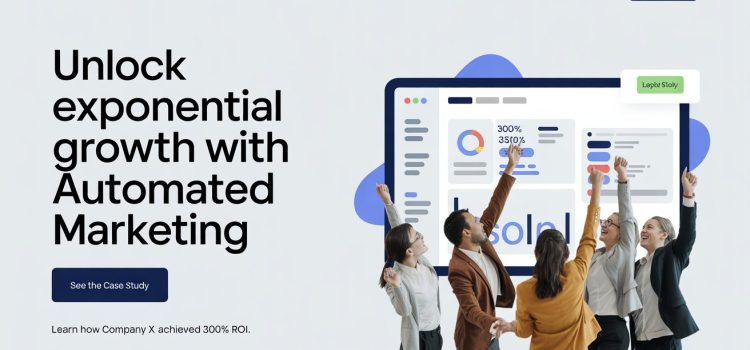
The Silent System Behind High-Performance Campaigns
Campaigns don’t go viral on hope. They rise because of structure, data, and timing. At the center of many high-ROI digital campaigns today lies a quiet but powerful operator — a digital marketing automation agency.
These agencies don’t just design creatives or write copy. They build repeatable systems that turn clicks into conversions, visitors into buyers, and customers into loyal advocates. While brands often get the spotlight, the real success stories are often shaped by the ones operating in the background.
What Defines a Digital Marketing Automation Agency
In simple terms, a digital marketing automation agency creates interconnected processes that automate and personalize digital outreach. These processes span across:
-
Email marketing workflows
-
Lead scoring and nurturing
-
Cross-channel integration (web, ads, CRM)
-
Data collection and performance analysis
The objective is not just visibility but action — enabling every digital asset to serve a purpose in the customer journey.
A Real Success Story Begins
One mid-sized business operating in Pakistan’s B2C skincare market had all the ingredients: a good product, a budget, and an online store. What they lacked was a system. Leads were coming in, but sales were inconsistent. Abandoned carts piled up. Email responses were late.
After engaging with a digital marketing automation agency, things began to change — not overnight, but fast enough to create a measurable shift in three months.
The First Fix: Map the Customer Journey
The agency’s first task was to understand how users moved through the funnel. It involved mapping every touchpoint:
-
Social media ad clicks
-
First website visit
-
Time spent on product pages
-
Abandonment triggers
-
Email open rates
-
Purchase behavior
From this data, they created automated responses based on actions, not assumptions.
Building The Right Automation System
Email Sequences That Act Like Sales Reps
Instead of sending weekly newsletters, the agency designed event-based emails that were triggered automatically:
-
Welcome emails after signup
-
Abandon cart nudges with dynamic content
-
Product recommendations based on browsing
-
Post-purchase check-ins
Each email sequence had a clear goal and a built-in time delay based on behavior.
CRM Integration for Smarter Segmentation
User data from forms, purchases, and ad interactions was unified in a single CRM. From here:
-
Leads were scored by level of engagement
-
Repeat buyers were separated from new visitors
-
Inactive users were marked for re-engagement
This ensured that every campaign spoke to the right people at the right moment.
Personalized Retargeting Ads
The agency connected the CRM to ad platforms like Facebook and Google. Using behavior-driven segmentation, they ran retargeting campaigns that reflected:
-
Abandoned product names
-
Last viewed categories
-
Ongoing deals for viewed items
As a result, ad spend dropped while conversions rose.
Analytics That Drove Continuous Improvement
Weekly performance reports weren’t just a formality. The agency tracked:
-
Email flow drop-off rates
-
ROI per campaign
-
Click heatmaps on landing pages
-
Conversion delays by device or time
These insights helped tweak messaging, redesign landing pages, and even reschedule email dispatches for higher visibility.
What Success Looked Like
In just 90 days of working with the digital marketing automation agency, the business saw:
-
3x growth in email open and click rates
-
45 percent recovery of abandoned carts
-
60 percent lift in retargeting ad ROAS
-
22 percent reduction in customer acquisition cost
-
80 percent increase in first-purchase conversions
None of this was due to doubling ad budgets. It came from using automation to squeeze more value out of each user touchpoint.
Why This Model Works Across Industries
The approach used by this agency isn’t limited to skincare or e-commerce. It applies broadly across sectors:
| Industry | Use Case Example |
|---|---|
| Education | Course drip emails, inquiry follow-ups |
| SaaS | Onboarding flows, feature adoption nudges |
| Real Estate | Property alerts, lead qualification sequences |
| Healthcare | Appointment reminders, follow-up campaigns |
| Events | RSVP management, event countdowns |
No matter the niche, automation ensures that no lead is lost and every interaction adds value.
Tools Behind the System
The agency didn’t rely on one tool but rather a mix:
-
Email Automation: Active Campaign, Klaviyo, MailerLite
-
CRM: HubSpot, Zoho, Pipedrive
-
Landing Pages: Unbounce, Elementor
-
Analytics: Google Data Studio, Hotjar
-
Ad Platforms: Meta Ads, Google Ads, LinkedIn Ads
What mattered was how these tools talked to each other — not which brand they belonged to.
Small Team, Big Impact
One of the most important insights from this case was that the business didn’t need a massive in-house marketing team. The agency managed the setup, monitoring, and optimization, while the internal team focused on product development and customer service.
This model reduced overheads and increased operational agility.
Avoiding Common Automation Pitfalls
Many companies fail at automation not because they lack tools, but because they make avoidable errors. The agency helped bypass these issues:
-
Over-automation: Sending too many messages too quickly
-
Poor data hygiene: Wrong segments due to unclean data
-
Generic flows: Same journey for every user type
-
Neglected testing: No A/B testing or version updates
By addressing these, the system stayed fresh, relevant, and impactful.
The Real Value of an Automation Agency
Hiring a digital marketing automation agency is not a luxury. For growth-oriented companies, it’s a strategic move. The value goes beyond numbers:
-
More consistent revenue cycles
-
Lower churn rates
-
Faster testing and learning
-
Better use of every marketing dollar
And most importantly, it creates bandwidth for the core team to focus on what they do best.
What Comes Next in Automation
Looking ahead, digital automation will go deeper into AI territory. Trends include:
-
Predictive content based on user patterns
-
Real-time email content personalization
-
WhatsApp and SMS automation
-
AI-powered lead scoring models
-
Hyper-personalized landing page experiences
Agencies leading the next wave will combine data science with storytelling to create systems that not only automate but also connect on a human level.
A Repeatable Success Blueprint
This success story wasn’t an accident. It was built on strategy, tested by data, and refined by action. Any business ready to grow smart can follow a similar path — with the right agency as a partner.










